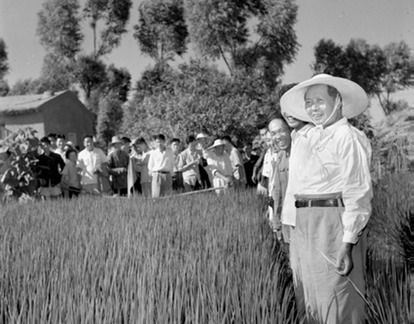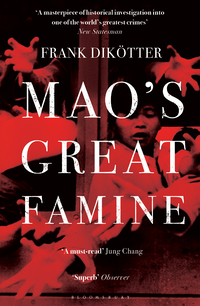National Observer, 31 January 2011
Mao’s Terror-Famine Claimed 45 Million Souls
Some books are destined to be so influential that they recast history in the public mind. Mao’s Great Famine is one such book. Mao is revealed as a manipulative, power-crazed dictator who would stop at nothing to create a “New China” out of the imperfect clay of the inhabitants of the world’s oldest continuous civilisation.
The Chinese people were not so malleable. Over five thousand years of history, China’s lao bai xing — literally “the old hundred names” or common people – have survived war, pestilence and famine. But no famine has been as awful and widespread as Mao’s politically induced famine, the so-called Great Leap Forward. This man-made famine killed at least 45 million people — the most devastating famine in China’s long history.
The first victims began dying of overwork, starvation and exposure during the mass mobilisation on water conservancy schemes which began in 1958. “All over China,” historian Frank Dikötter tells us, “farmers were being driven to the edge of starvation on gigantic irrigation schemes, pushed hard by cadres afraid of being labelled rightists.” These irrigation schemes were almost all useless, or to be more correct, counter-productive.
In a chilling precursor to Cambodia under the Khmer Rouge, villagers called these projects “the killing fields”. Of the farmers conscripted to transform all China by hand, hoe and shovel, several hundred thousand, already weakened by hunger, died where they worked. At first, they were buried in coffins; later, they were dumped into ditches and ponds near the construction site.
The first lunatic round of the Great Leap Forward was steel fever. Steel has a particular role in socialist mythology. “Here was material worth to stand for socialism — hard, shiny, industrial, modern and working-class. ‘Stalin’ stood for a man of steel willing to smash all the enemies of the revolution to smithereens. Smoking factor stacks, whirring machine tools, the hooting of factory whistles, towering blast furnaces glowing deep red with fire: these were the consecrated images of socialist modernity” (p. 57).
Mao’s aim was to overtake Britain — then the Soviet Union and, finally, by 1962, the United States — in steel production, with China eventually pulling away to lead the world. But Mao’s plan to this end was to use the farmers in the villages to make steel. Home-made blast furnaces, made of bricks, stone, fireclay or sand were to be the means of steel production. Some backyard blast furnaces may have worked, but most of them were shams. The cadres, frantic to meet the targets on which their preferment rested, began going door to door, collecting scrap iron and even confiscating household implements and farming tools.
Almost all of the steel produced in backyard furnaces in 1958 was useless. Too brittle and too small to be used in rolling mills, it was also at least twice as expensive as steel from modern blast furnaces. Meanwhile, with farmers digging ineffectual and dangerous dams and other infrastructure projects, and working in factories, women with little or no knowledge of farming were left to tend the fields.
Among the Han Chinese (who account for 95 per cent of China’s population) women traditionally worked at home. Hakka (a culturally distinct subgroup of Han Chinese) women worked in the fields, but traditional Han Chinese women concentrated on handicrafts for sale and managing the home, so they had virtually no farming knowledge or experience of agriculture.
Counterproductive farming “innovations”, such as deep ploughing and close cropping, created more setbacks. To make matters worse, community granaries were poorly managed. Villagers dreaded each new campaign in the “continuous revolution”. Food was in the hands of the communes; those who fell afoul of the authorities went hungry. Even so, many farmers protested over the waste and pointlessness of these campaigns.
By 1961, failings in the Great Leap Forward were becoming obvious, even to those cocooned in the party leaders’ compound in Beijing. Mao described the reports as a “bourgeois backlash”. “Who would have thought,” Mao complained, “that the countryside harboured so many counter-revolutionaries? We did not expect that the counter-revolution would usurp power at the village level and would carry out cruel acts of class revenge.” Such is the power of self-delusion.
Mao claimed that the grassroots reports were misleading the leadership, so he dispatched several high-powered teams to inspect the countryside. Among them was China’s head of state, Liu Shaoqi, who also hailed from a Hunanese village within easy driving distance from Mao’s hometown. Liu was shocked by the conditions in his home village, where the people were on the verge of starvation. Following his return to Beijing, Liu spoke his mind, as he had promised to villagers in his home town that he would.
Liu was a party loyalist, but he had been shaken in his faith. The break with Mao over the man-made famine was to have dire consequences for Liu during the Cultural Revolution, when Mao would denounce him as a traitor and “capitalist roader”, expel him from public office and send him to prison where he died in mysterious circumstances.
Even at the height of the famine, food and grain were confiscated by the central authorities. While the farmers were starving to death, the cities were fed, and grain was exported to Beijing’s allies. In the mad dash to overtake both the Soviet Union and the West, agricultural output was wildly overestimated by cadres from the village level up. As during the Irish potato famine in the 1840s, so with China: the nation was exporting food while its people (tens of millions in the Chinese case) starved to death.
Soon, hard pressed to beat impossible targets, manufacturing plants began to turn out shoddy goods that would blight China’s reputation as a reliable supplier of manufactured goods for decades. To make matters worse, in the villages houses were torn down, sometimes to be used as fertiliser, and sometimes to be turned into grandiose building projects with luxuries unheard-of in most villages and towns: luxurious theatres, elevators, dance halls, photographic studios and private toilets.
“It is difficult to estimate how much was destroyed,” writes Professor Dikötter. “The situation varied tremendously from place to place, but overall the Great Leap Forward constitutes, by far, the greatest demolition of property in human history.” Dikötter adds that roughly 30 to 40 per cent of all houses were turned into rubble. In retaliation, workers slackened their output at factories and in the fields. Farmers often worked all day with nothing to eat, while officials gorged on huge meals at “conferences”. The more meetings there were, the more officials could eat.
In this officially induced famine, sheer survival for most people meant stealing as much as they could, abandoning customary moral standards. The cadres enforcing food distribution were hated, and each village seemed to have a cadre popularly known as the King of Hell who tormented the villagers.
Collectivisation meant that the cadres controlled what came out of the one big pot at the village canteen. The elderly, typically revered in Chinese society, feared loneliness, poverty and abandonment as the traditionally close family ties were strained by starvation. In a situation where the cadres — by the distribution of food and favours — often controlled who would live and die, they commonly beat “malingerers” to death, without fear of retaliation. Higher-level cadres even encouraged village-level cadres to create a condition of fear by frequent beatings to the point of death. Often beatings were of the “kill a chicken to frighten a monkey” variety, but terror and violence ruled as a means to keep order, even as farmers and their families starved to death. Others punishments were to be buried alive, to be burned to death, and to have one’s limbs hacked off.
Access to archives in China has allowed scholars to gain access in recent years to information that was previously off-limits. Working with reports that are frequently inaccurate and which require rigorous cross-checking, Dikötter and others have arrived at a figure of a minimum of 45 million deaths to the Great Leap Forward of 1958-62. It was the worst famine in China’s long history, and it was entirely man-made.

